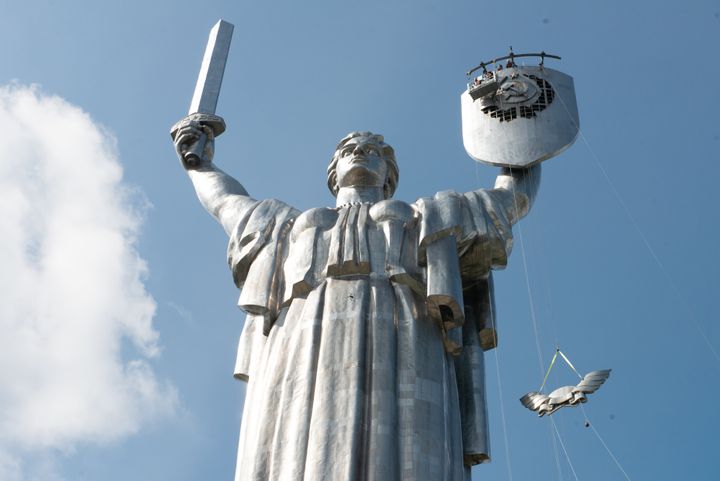
Ukraine just made a noteworthy change to its a giant monument to show – once again – how its relationship with Russia has collapsed.
Moscow invaded its European neighbour last February, and a bloody war has been raging ever since.
Russia currently occupies a fifth of Ukrainian land, having launched a “special military operation” under the guise of liberating Kyiv from its “neo-Nazi” government (although this is a baseless claim).
More than 9,000 Ukrainian civilians, including more than 500 children, have died since Vladimir Putin ordered his troops to invade.
Still, almost 18 months since the war began, Moscow is still fighting to control Ukrainian land.
Now, Ukraine has removed the Soviet hammer and sickle from a famous statue in the capital of Kyiv, known as the Motherland Monument.
Around 62m in height, it stands near the National Museum of the History of Ukraine in the Second World War, and weighs 560 tonnes.
The statue, first put up in 1981, shows a woman, known locally as Baba, staring eastwards, holding a 16m sword and an eight-metre shield.
But as of July 30, the shield no longer has the hammer and sickle symbol of the Soviet Union emblazoned on it, the symbol meant to represent the industrial worker and peasant of communism.
But, as part of the ongoing removal of any Russian influence within the country, this was removed and replaced with the emblem of Ukraine, a trident over the weekend.
As the FT correspondent Christopher Miller noted on Twitter, this was a “remarkable moment filled with symbolism”.
Oleksandr Tkachenko – then Ukraine’s culture minister – explained this decision by saying there is “serious public demand for the process of overcoming the consequences of Sovietisation, Russification of Ukraine” earlier this month, according to Politico.
When the dismantling work began over the weekend, he wrote on Twitter that the monument would now become “mother Ukraine in all senses”.
Tkachenko actually resigned after the Ukrainian president Volodymyr Zelenskyy called for spending controls last month – and there was some backlash over the supposed cost of changing the monument amid a costly war.
But, the former culture secretary has maintained that such projects were still important in wartime, writing on Facebook last Friday: “Some say it is not the time to spend money on culture during the war. But tell me then, what are we fighting for? Aren’t we fighting for our culture, identity, language, and history? Culture during the war is as important as drones.“
The makeover for the Motherland monument reportedly did not come from public funds but from big businesses.
